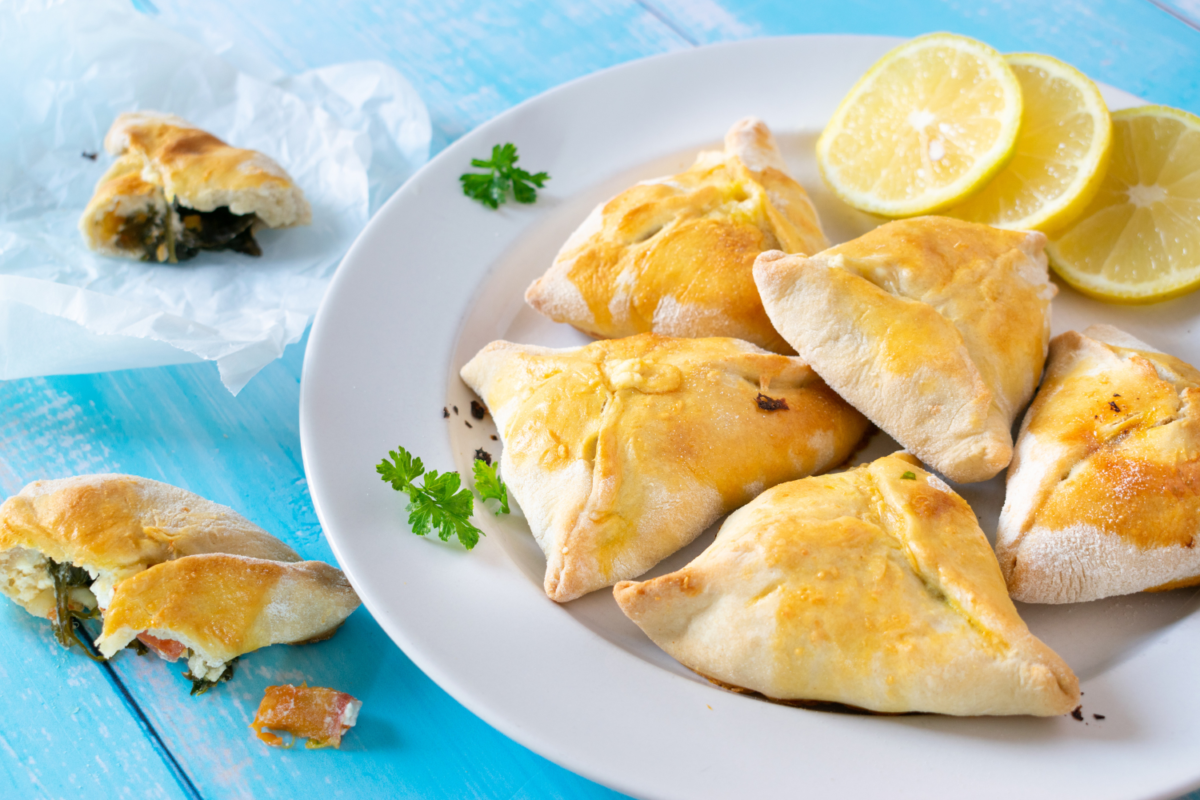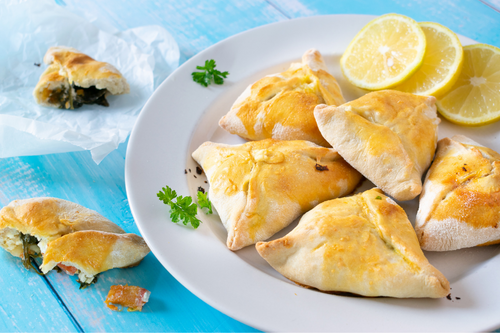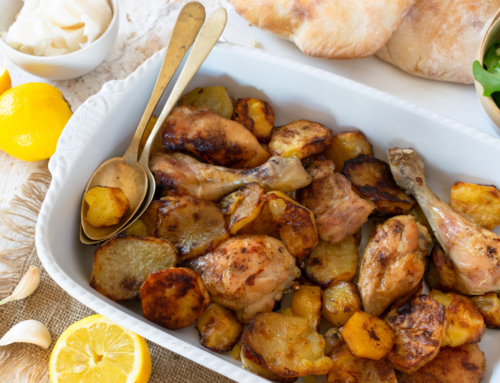These delectable Lebanese spinach pies are best enjoyed fresh out of the oven but can be a great on-the-go snack option as well. The salty feta and Middle Eastern spices make these spinach pies a must-try for all Mediterranean food lovers.
Spinach Pies: A Childhood Favorite
Perhaps the best thing we learned in our childhood from animated cartoons is that eating spinach, like Popeye the Sailor Man does, will benefit our health because it is rich in many nutrients. This includes Vitamin A, Vitamin C, Vitamin K, iron, folate, and potassium.
Fatayer bi sabanekh means spinach pie in Arabic. They’re basically the spanakopita of the Middle East. However, while the literal translation is spinach pies, Lebanese people don’t consider them to be pies, perhaps due to their triangular shape. But Lebanese spinach triangles don’t have quite the same ring to them!

The popular Lebanese street food is similar to manakeesh (Middle Eastern flatbread) because it’s commonly found in different sizes in Lebanese bakeries. This Lebanese fatayer recipe is usually served as a side dish, while some people eat them as a main dish when fasting for Lent.
Personally, I loved to take fatayer spinach to school when I was a child, as it was small, tasty, and portable. My mom used to make fatayer with different stuffings, like spinach, cheese, and my favorite, parsley. It was amusing for me to choose which edge of the fatayer triangle to bite first.
Today though, we’re focusing on a classic Lebanese spinach pie recipe. Besides spinach, our filling includes onion, tomato, feta, and lots of delicious spices like sumac, a popular Middle Eastern spice. The combination of sumac with fresh lemon juice gives the Lebanese spinach pies a tantalizing citrus taste. The filling is baked in a homemade dough that’s super easy to make. Don’t forget to squeeze some fresh lemon juice on your Arabic spinach pies, it will awaken the taste!
Notes
- You can easily substitute ribbed Swiss chard for spinach if you prefer that vegetable, though Swiss chard is not as nutritious as spinach.
- To make these into vegan spinach pies, simply omit the crumbled feta.
- For added texture, add a tablespoon of pine nuts or chopped walnuts to the filling. You get bonus points if you toast them beforehand.
- For added flavor, you can cook the onion before adding it to the filling. You’ll need to let the caramelized onions cool first though, as they’ll cook the spinach, which we don’t want.
- If you want a touch of heat, stir in ¼ teaspoon of cayenne pepper to the filling.
- If you have it on hand, many Lebanese spinach pies include a tablespoon of pomegranate molasses for a richer taste, but this is an optional ingredient.
- You can make spinach fatayer by using frozen spinach or fresh. However, the most important thing is to squeeze as much moisture as possible out of the spinach before adding it to the filling.
- If you want to save time when making these easy spinach pies, you can use store-bought bread dough.
FAQs
What is fatayer made of?
Fatayer is the name for a savory hand-held pie usually stuffed with meat, spinach, or cheese like feta or akkawi. It’s one of the most popular Middle Eastern recipes and is eaten in countries like Iraq, Egypt, Lebanon, Jordan, and Israel.
What do you eat fatayer with?
This Lebanese spinach pies recipe is enjoyed any time of day from breakfast to dinner as a side dish, snack, or main meal. However, it’s also regularly enjoyed with other dishes as part of a mezze spread. They can be served alongside other popular Lebanese dishes like hummus, stuffed grape leaves, and baba ganoush.
How do you fold a fatayer?
We’ve included written instructions in the recipe card, but here’s a visual aid to help you learn how to fold a Middle Eastern spinach pie.
How do you store leftover Lebanese spinach pies?
You can store baked fatayer leftovers in an airtight container in the fridge for up to 7 days. I recommend reheating them quickly either in the oven or air fryer. You can also freeze leftovers for up to 3 months. Thaw in the fridge overnight before reheating in the oven or air fryer.
What can I use instead of sumac?
Sumac has a very distinct flavor that’s hard to replicate. The best you can do is combine lemon pepper seasoning with some fresh lemon zest if you can’t find sumac.

Lebanese Spinach Pies (Fatayer)
Ingredients
For the Dough:
- 5 1/2 cups bread flour
- 2 teaspoons salt
- 2 teaspoons sugar
- 4 teaspoons yeast
- 2 cups warm water
- 1/2 cup olive oil
- 1 egg, beaten
For the Spinach Filling:
- 1 pound fresh spinach (about 2 large bunches), de-stemmed and roughly chopped
- 1 teaspoon salt
- 1 small onion, peeled and diced
- 1 small tomato, peeled and diced
- 1 tablespoon olive oil
- freshly squeezed juice of 1/2 lemon
- 1 tablespoon sumac
- 1/4 teaspoon black pepper
- 1/2 teaspoon Lebanese 7 spice seasoning, optional
- 2 teaspoons apple cider vinegar
- 1 cup crumbled feta, optional
For Serving:
- freshly squeezed lemon juice
Instructions
- For the fatayer dough, in a large bowl, mix the flour, salt, sugar, and yeast. Using the back of a wooden spoon, make a hole in the mix and pour the water and olive oil into the hole. Mix the ingredients together well with a wooden spoon or your hands, as is the Lebanese practice. Continue mixing and kneading until the dough comes together as a whole piece.
- Form the dough into a round, and place it in a large bowl. Coat the dough with a little olive oil.
- Cover the bowl with a kitchen towel and leave it in a warm place for about 1 hour until it’s doubled in size.
- Make the filling while the dough rises. Put the spinach in a large bowl, sprinkle it with the salt, and set it aside for 10 minutes. Squeeze the spinach to drain any water, then chop it into small pieces.
- Add the onions, tomatoes, olive oil, lemon juice, vinegar, sumac, pepper, 7 spice seasoning, and vinegar. Mix until the ingredients are well combined.
- When the dough rises, punch it down and knead it a bit. Divide the dough into 16 small balls. Cover the balls with the towel and let them rest for 10 minutes.
- On a floured surface, use a rolling pin, to roll the balls into ¼-inch, or a little thinner, circles. Let the circles rest for 10 minutes.
- While the circles rest, put 2 baking sheets in the oven and preheat it to 400 degrees F.
- To make the fatayer, put ¼ cup of spinach filling in the middle of a circle, and top it with 1 tablespoon of feta, if using. Bring two sides of the dough together, then pinch to close them. Bring up the third side and pinch to close it, making a triangle. Brush the fatayer with the egg.
- With a potholder, remove the baking sheets from the oven and dust them with flour. Put 4 to 5 of the fatayer on each baking sheet to allow room for the dough to rise more as they bake. Bake the fatayer for 15 to 18 minutes, until they become golden. Bake the remaining fatayer.
- Serve the fatayer warm with lemon juice.





